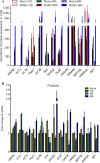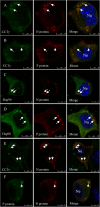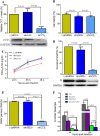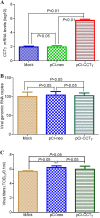Cellular chaperonin CCTγ contributes to rabies virus replication during infection
- PMID: 23637400
- PMCID: PMC3700271
- DOI: 10.1128/JVI.03186-12
Cellular chaperonin CCTγ contributes to rabies virus replication during infection
Abstract
Rabies, as the oldest known infectious disease, remains a serious threat to public health worldwide. The eukaryotic cytosolic chaperonin TRiC/CCT complex facilitates the folding of proteins through ATP hydrolysis. Here, we investigated the expression, cellular localization, and function of neuronal CCTγ during neurotropic rabies virus (RABV) infection using mouse N2a cells as a model. Following RABV infection, 24 altered proteins were identified by using two-dimensional electrophoresis and mass spectrometry, including 20 upregulated proteins and 4 downregulated proteins. In mouse N2a cells infected with RABV or cotransfected with RABV genes encoding nucleoprotein (N) and phosphoprotein (P), confocal microscopy demonstrated that upregulated cellular CCTγ was colocalized with viral proteins N and P, which formed a hollow cricoid inclusion within the region around the nucleus. These inclusions, which correspond to Negri bodies (NBs), did not form in mouse N2a cells only expressing the viral protein N or P. Knockdown of CCTγ by lentivirus-mediated RNA interference led to significant inhibition of RABV replication. These results demonstrate that the complex consisting of viral proteins N and P recruits CCTγ to NBs and identify the chaperonin CCTγ as a host factor that facilitates intracellular RABV replication. This work illustrates how viruses can utilize cellular chaperonins and compartmentalization for their own benefit.
Figures






Similar articles
-
The chaperonin CCTα is required for efficient transcription and replication of rabies virus.Microbiol Immunol. 2014 Oct;58(10):590-9. doi: 10.1111/1348-0421.12186. Microbiol Immunol. 2014. PMID: 25082455
-
Toll-like receptor 3 (TLR3) plays a major role in the formation of rabies virus Negri Bodies.PLoS Pathog. 2009 Feb;5(2):e1000315. doi: 10.1371/journal.ppat.1000315. Epub 2009 Feb 27. PLoS Pathog. 2009. PMID: 19247444 Free PMC article.
-
Lipid Droplets Are Beneficial for Rabies Virus Replication by Facilitating Viral Budding.J Virol. 2022 Jan 26;96(2):e0147321. doi: 10.1128/JVI.01473-21. Epub 2021 Nov 10. J Virol. 2022. PMID: 34757839 Free PMC article.
-
Rabies virus transcription and replication.Adv Virus Res. 2011;79:1-22. doi: 10.1016/B978-0-12-387040-7.00001-9. Adv Virus Res. 2011. PMID: 21601039 Review.
-
Structure and Function of Negri Bodies.Adv Exp Med Biol. 2019;1215:111-127. doi: 10.1007/978-3-030-14741-9_6. Adv Exp Med Biol. 2019. PMID: 31317498 Review.
Cited by
-
Human Papillomavirus infection requires the CCT Chaperonin Complex.J Virol. 2021 May 10;95(11):e01943-20. doi: 10.1128/JVI.01943-20. Epub 2021 Mar 17. J Virol. 2021. PMID: 33731457 Free PMC article.
-
Quantitative analysis of acetylation in peste des petits ruminants virus-infected Vero cells.Virol J. 2023 Oct 10;20(1):227. doi: 10.1186/s12985-023-02200-1. Virol J. 2023. PMID: 37817180 Free PMC article.
-
Pathogenicity and tissue distribution of grass carp reovirus after intraperitoneal administration.Virol J. 2014 Oct 7;11:178. doi: 10.1186/1743-422X-11-178. Virol J. 2014. PMID: 25293723 Free PMC article.
-
Structure and function of S9 segment of grass carp reovirus Anhui strain.Virusdisease. 2017 Mar;28(1):26-32. doi: 10.1007/s13337-016-0357-1. Epub 2017 Jan 16. Virusdisease. 2017. PMID: 28466052 Free PMC article.
-
Murine cytomegalovirus M72 promotes acute virus replication in vivo and is a substrate of the TRiC/CCT complex.Virology. 2018 Sep;522:92-105. doi: 10.1016/j.virol.2018.07.008. Epub 2018 Jul 18. Virology. 2018. PMID: 30029015 Free PMC article.
References
-
- Lafon M. 2011. Evasive strategies in rabies virus infection. Adv. Virus Res. 79:33–53 - PubMed
-
- Jamin M, Leyrat C, Ribeiro EA, Gerard FCA, Ivanov I, Ruigrok RWH. 2011. Structure, interactions with host cell and functions of rhabdovirus phosphoprotein. Future Virol. 6:465–481
-
- WHO September 2012. Rabies: fact sheet no. 99. World Health Organization, Geneva, Switzerland: http://www.who.int/mediacentre/factsheets/fs099/en/ Accessed 26 December 2012
-
- Negri A. 1903. Contributo allo studio dell'eziologia della rabbia. Boll. Soc. Med. Chir. Pavia 2:88–115
-
- Suchy A, Bauder B, Gelbmann W, Lohr CV, Teifke JP, Weissenbock H. 2000. Diagnosis of feline herpesvirus infection by immunohistochemistry, polymerase chain reaction, and in situ hybridization. J. Vet. Diagn. Invest. 12:186–191 - PubMed
Publication types
MeSH terms
Substances
LinkOut - more resources
Full Text Sources
Other Literature Sources
Medical
Research Materials
Miscellaneous

